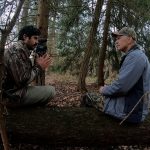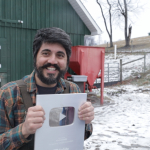Homesteady Podcast 116 Simple Way to Make 10X MORE MONEY FARMING with Jordan from Farm Builder
Want to start or grow a farm from scratch to be your full time income? Checkout Farm Builder…
JORDANS YOUTUBE CHANNEL
JORDANS FARM
FARM BUILDER SCHOOLS
MOST farmers don’t make enough money from their efforts to live off their earnings.
It’s a sad but true statement.
An article written last year on the usda website stated that 96% of farm households get some income from off-farm sources and on average that off-farm income was 82 of their total income.
Yep. Farming for a living is hard.
And yet many of us want the life of a farmer…
So, can it be done? Can we make a living… living the life we want, farming full time? YES.
Jordan and his wife Laura figured out how to do this starting a regenerative multi-species pasture-based farm from scratch, both of them coming out of military jobs!
How? He shares their story in the latest episode of our podcast!
Jordan didn’t exactly grow up farming.
“I did not grow up on a farm per se. I grew up on what now would now be called a homestead. We had egg laying chickens, a few pigs, and a herd of dairy goats.
My dad is a landscaper by trade, all the kids worked in the landscaping business as well and the farm. It was the kind of the thing that helped put food on the table, and i’m beginning to suspect it was also something to keep all the kids busy. Plenty of plenty of chores for the kids to do to keep them out of your hair.”
When Jordan was old enough, his very first job was working in a production layer chicken house.
“I was working on a local farm about five ten miles down the road. They had horses they also had two commodity poultry houses.
That was a unique experience to work inside a commodity system first and see what the inside of the commodity poultry industry looks. It’s not very pleasant.”
Jordan was just the kid who cleaned the dead birds and made sure the eggs were rolling back into the egg boxes, ‘basically the entry level peon’ as he puts it.
Although Jordan didn’t love working at the commodity chicken house, he did enjoy working in agriculture and he wound up landing an internship at a very special farm… Polyface Farm.
“I was reading some of Joel Salatin’s early books, I wound up going down and seeing Polyface farm and ended up getting an apprenticeship there in 2001.
I was 19 years old, and I got to spend about 13 months learning these pasture-based production models at a more scaled operation. More than just the 50 chickens in the backyard, this was 10,000 chickens in the in the backyard, and lots of pigs and beef.”
Jordan had a love for agricultrue at this point, and a desire to start farming, but he wasn’t in a position at that time to start his own farm yet.
“For a few years after Polyface, I helped other people start farming.
Like one guy I helped start farming, he was a medical device salesman. They make pretty good money, and he wanted to have this farm but he didn’t know a lick about farming at all, and so it worked out well for both of us!
He had the money to fund starting the farm, I had more experience than he had in doing it, so I was able to get him started with a small poultry operation and some cows. That’s kind of what I helped people do for a few years.”
Do you want to start your own farm, but are not yet in a place to? Why not do what Jordan did. gain some hands on expirence working as an aprentice on others farms, and then perhapes even help people start their farms before making the leap to start your own!
As Jordan says… “it’s great to practice with other people’s money!”
It was at this point that Jordan had a major detour from the farming career.
“They definitely got me with the posters when I was a teenager. I Wanted to go to the marine corps.
I ended up having the opportunity to go to the marine corps after Polyface. I did that for five years.
No regrets doing that, I got to see a lot of cool places around the world do do cool things but it wasn’t what I really wanted to do for 20 years.
I got married while I was in.
My wife Laura (who also comes from that kind of homestead, homeschool, home birth, home everything background) and I started having conversations about starting this farm idea.
It was about 12 or 18 months of developing the ideas of what we wanted to do. It was always our intention to jump into it full-time out the gate. We didn’t want to have off farm jobs and then try to do the farm, the farm was going to be our full-time thing.”
They made the leap. They left the military to farm. But they didn’t own any land… So what did they do?
“We did not buy land, we leased land for the first 11 years that we had this business. We found a 200 acre farm that was owned by a couple in their early 50s that was looking for some young people.”
Jordan refers to this opportunity as on of his “unfair advantages”.
“You’re looking for what’s your unfair advantage. Anytime you’re starting a business you always have to look at what is your unfair advantage above your competition. Basically so for us we found land, it was cheap for us to start operating on.”
Land is just the beginning of the farm equation though. 
“The second thing is capital. It does take money to start a businesses. Fortunately we had a family member that believed in us and what we were doing and ended up fronting us about a hundred grand in capital to get started with which we then repaid over the next nine years.”
The next thing you have to address is your market or opportunity.
“Where is the opportunity in the market for a product that you can produce?”
Jordan warns that “oftentimes you’re not gonna know necessarily what that product is until you actually engage the marketplace itself.”
I love how Jordan puts this… ‘Engaging the marketplace.’
He’s a military man and when he uses that word, ‘engage’ I think of that idea of engaging an enemy, or opponent. We can come up with a plan how we’re going to outsmart our opponent how we’re going to defeat them, but so much changes the minute we actually engage our opponent or in this circumstance the marketplace.
We can dream all day of how our farmers market stand is going to look and how much we’re going to ask for farm fresh eggs but until we make our first sale we just don’t have enough information to truly build a successful farm business.
Jordan and his wife engaged their marketplace for a few years before they found the right niche for their farm!
First they tried selling pastured poultry. But they quickly learned that they were in a very saturated market for pastured poultry. It was then that pigs became a focus of their farm.
“Polyface had just picked up chipotle, and they needed more production on pigs. They said hey if you want to grow pigs for us next year we’ll we’ll buy them from. That immediately gave us a little bit of market there and an opportunity to pursue, but that wasn’t the the big opportunity.
We started producing pigs, and we realized there was a shortage of piglets in the local area. Polyface was buying a lot so we were kind of left with the scraps.”
While literally catching piglets underneath junk cars in junkyards, Jordan realized he needed to start a pig farrowing operation!
“It was two, three years into operating the farm that that the real golden opportunity for us opened up and that was to supply piglets. There was no competition and just a wide open market producing piglets.
There’s all these other farms starting and competing in this direct to retail space but there’s no one there to get to supply them with their piglets and that ended up becoming our our centerpiece enterprise.
That was an opportunity that we never would have known doing a feasibility study or kind of the academic business review before we actually got into the weeds and started operating the business. That that’s something I really like to encourage people with, it’s worth writing a business plan and doing kind of those numbers and projections and stuff, but also realize that once your boots are on the ground, you know the the maxim from the military side is no battle plan survives first contact.
They had made some HUGE progress in growing their farm business. They had acquired land, funded their operation, and finally identified an opportunity that they could grow their business from. But they still were scraping by.
“The first years were definitely tough. Our first year I think we paid ourselves about 10 grand for the year.”
Jordan was ‘rationing quarters to go buy a can of Dr Pepper.’
“That was kind of what it took for us to get the the farm off the ground. Keeping that capital and that equity cycling inside inside of the business instead of pulling it off for a personal income.”
Slowly, by reinvesting the money they made back into the farm, the business grew.
“No matter what you’re doing as a business, you are in the process of cycling capital through a business operation and taking a profit margin on the capital and then accelerating that cycle as many times as you can.
Fundamentally what we are looking at is once we have arrived at a profitable model whether it’s with beef, pork, poultry, produce or whatever, is what can we do to tighten that cycle up so that we now are rotating that capital more and more frequently?”
Basically, Jordan and his team would figure out what was profitable for them, and what wasn’t. They would then CUT what wasn’t profitable completely, and work to improve what was profitable.
“Our capital has to make money going through this business and if it’s not then we need to stop doing it. So, like for our farm we do we do not produce any eggs on our farm now. It’s a very hard product to make margin on, we have to produce something that is giving a return on the capital that we’ve engaged into the into the farm, otherwise we’re going to be an unprofitable operation for a short period of time, we will be a charity operation for a period of time after that, and then we’ll be a bankrupt operation at some point pretty closely in the future.”
Sometimes a loser needs cut. Other times you can repackage something to improve how much money you earn from it…
HOW TO 10X YOUR FARM INCOME…
Jordan tells a story that started standing in a grocery store isle…
“Maybe six, seven years ago I went into the local convenience store here and they had this new product on the shelf, smoked bacon jerky.
I think it was like six bucks a bag or something like that.”
Jordan had to try it.
“I bought it, took it out to the truck, ate it, delicious. Then the business mine clicked in.
It was like 1.5 ounces. Basically it translated to like $50 a pound for for bacon, AND people were buying it!
The lesson from that is there is a a price point for everything that the market will tolerate. You just have to find what configuration of your product matches the market’s ability to bear the price.”
I’m gonna repeat that because it’s such a good point.
You have to find what configuration of your product matches the market’s ability to bear the price.
Basically Jordan’s saying you might have to change how you present your product, the way it looks, smells, or the way it’s served, to make the amount of money you need to be a successful farmer.
So maybe don’t sell half a pig, sell bacon jerky. Or don’t sell apples, sell pies. Or
DON’T SELL FARM FRESH EGGS… SELL MC’MUFFINS…
Jordan did just this.
“Back when we used to do farmer’s markets one of our hottest selling items up for the Saturday morning market, it wasn’t a steak, it wasn’t a pork chop or something like that, it was a sausage egg and cheese muffin.
When you produce pigs you get a lot of sausage. We also had like 3 000 egg layers at this point and so we had a lot of these small pullet eggs which are notoriously hard to sell.
The thought hit us one day, ‘what if we did you know, a mcmuffin kind of thing and that would allow us to use the sausage and it would also allow us to use these pee-wee eggs because we would just put two on it instead of one…’
We fooled around with the idea and we ended up building a whole farmers market trailer just to do this this one thing. We were selling them for $4.50 per muffin and we would sell on a good morning 400 of them.”
That’s almost $2000 a day from undersized eggs and some bulk sausage.
This is Jordans example, but you can come up with your own version.
Jordan puts it this way… “You just have to figure out what it is. The obstacle to overcome is that one in your mind, saying ‘I only want to sell whole pigs or I only want to have a csa or I’m just another guy selling tomatoes.’
That may not work.
BUT if you can change how you configure that product to the market, you can find that niche that can be very profitable for you.
If you can have the flexibility in your marketing and sales and what you do with your product you can sell pretty much anything anywhere.”
So there’s your challenge. You can pretty much sell anything, anywhere if you just figure out the way the market is ready to accept your product at the price point you need.
So what have you been thinking about selling from your homestead? Is it farm fresh eggs? Alpaca fiber? Farm fresh pork?
Maybe do a little bitty brainstorm and try to think of some creative ways that you can sell it and let us know in the comments what do you want to sell and how are you going to get creative with selling it so you can make what you need to from it!
Want to start or grow a farm from scratch to be your full time income? Checkout Farm Builder…
JORDANS YOUTUBE CHANNEL
JORDANS FARM
FARM BUILDER SCHOOLS
WANT TO MAKE MONEY HOMESTEADING?
The Pioneer Pro Program is a new program I am excited to announce here at Homesteady! You get access to the pioneer library, invited to all the interviews we have and all the bonus content pioneers get, AND it’s also bundled with the Make Money Homesteading course! This is a course that I designed to help you take the little baby steps it takes to go from wanting to make money from your homestead to actually having a product and the infrastructure in place to sell that product! It’s a one month long course but you can take it at your own pace and right now it’s bundled with the pioneer program to make this pioneer pro program!
CLICK HERE to learn more about the Pioneer Pro Program!




Is this a good plan for someone who already has established a business selling seed? Thank you